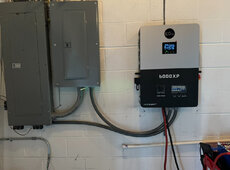Have (2) questions related to EG4 6000XP and EG4 LL-S 48V battery.
----
(1) What size cable size from inverter to batter - 1 AWG or 2 AWG?
System will have (2) EG4 LL-S batteries and expand to (4) at some point.
The manual for the EG4 6000XP recommends a 1 AWG cable to connect to battery terminal but the EG4 LL-S manual recommends a 2 AWG cable to connect battery terminal. Seems like many simply recommend going with 2AWG wire.
EG4 6000XP Manual (p.15) -
https://eg4electronics.com/backend/wp-content/uploads/2023/10/EG4-6000XP-Manual.pdf
EG4 LL-S Manual (p. 12) -
https://eg4electronics.com/backend/wp-content/uploads/2023/09/EG4-LL-S-48V-100AH-Manual.pdf
------
(2) What cable size for connecting battery to battery?
EG4 LL-S come with 6 AWG cable to connect battery to server rack but no mention, that I found, related to battery to battery.

Thanks!
Just another view for a worst case perspective:
Looking at the 6000XP output capabilities both peak and continuous. And figuring the needed battery power after factoring the efficiencies of 6000XP;
6000XP Output (W) / Efficiency = Need Battery Power (W)
6000W (continuous) / 0.93 = 6,452 watts of battery (continuous)
11,000W (5 sec) / 0.93 = 11,827 watts of battery (5 sec)
12,000W (3.5 sec) / 0.93 = 12,903 watts (3.5 sec)
Inverter to Battery Server Rack:
This yields a worst case battery current between 6000XP inverter and two EG4-LL-S batteries both peak and continuous;
Battery(W) / Lowest Battery Voltage = Battery (Amps) worst case
Continuous: 6,452W / 48V = 134.4 Amps => 4 AWG NEC 2020 Table 310.17 (Free Air)
Peak 5 sec: 11,827W / 48V = 246.5 Amps => 1/0 AWG NEC 2020 Table 310.17 (Free Air)
Peak 3.5 sec: 12,903W / 48V = 268.8 Amps => 2/0 AWG NEC 2020 Table 310.17 (Free Air)
Note: Note while using two EG4-LL-S batteries you may not have the ability to meet the peaks demands of the 6000XP. This may not be a problem depending upon the demands of your load.
Comments: I would recommend the 2/0 AWG wire between the battery server rack and 6000XP inverter. Yes, it’s a little more expensive but it’s a short run. This would allow for an acceptable level of heating (per NEC 2020) within the wiring during peak operation of the 6000XP inverter.
Battery to Server Rack Cable size:
Assuming the two EG4-LL-S batteries are in a server rack utilizing the buss bars. The 6 AWG wire that comes with the battery is almost adequate per NEC 2020 Table 310.17 (Free Air) but you may want to consider another battery so that three batteries share the peak demand.
6 AWG -> 105 amps => assuming 90 degree C, THHN or USE-2, Free Air, per NEC 2020 Table 310.17
4 AWG -> 140 amps => assuming 90 degree C, THHN or USE-2, Free Air, per NEC 2020 Table 310.17
Two sets of 6 AWG wires connecting two batteries to buss bars within server rack allows for 210 amps of wire capacity to the inverter. This is ok for continuous however during peak time you may generate a little heat on your cables.
When you add a third battery your wire capacity allows for 315 amps to the inverter. This arrangement would meet the demand of the 6000XP inverter. However, if two batteries are all you have at the moment, then 4 AWG wires will give you a 280 amp capacity to meet the peak demands of the inverter.
Hope this helps





